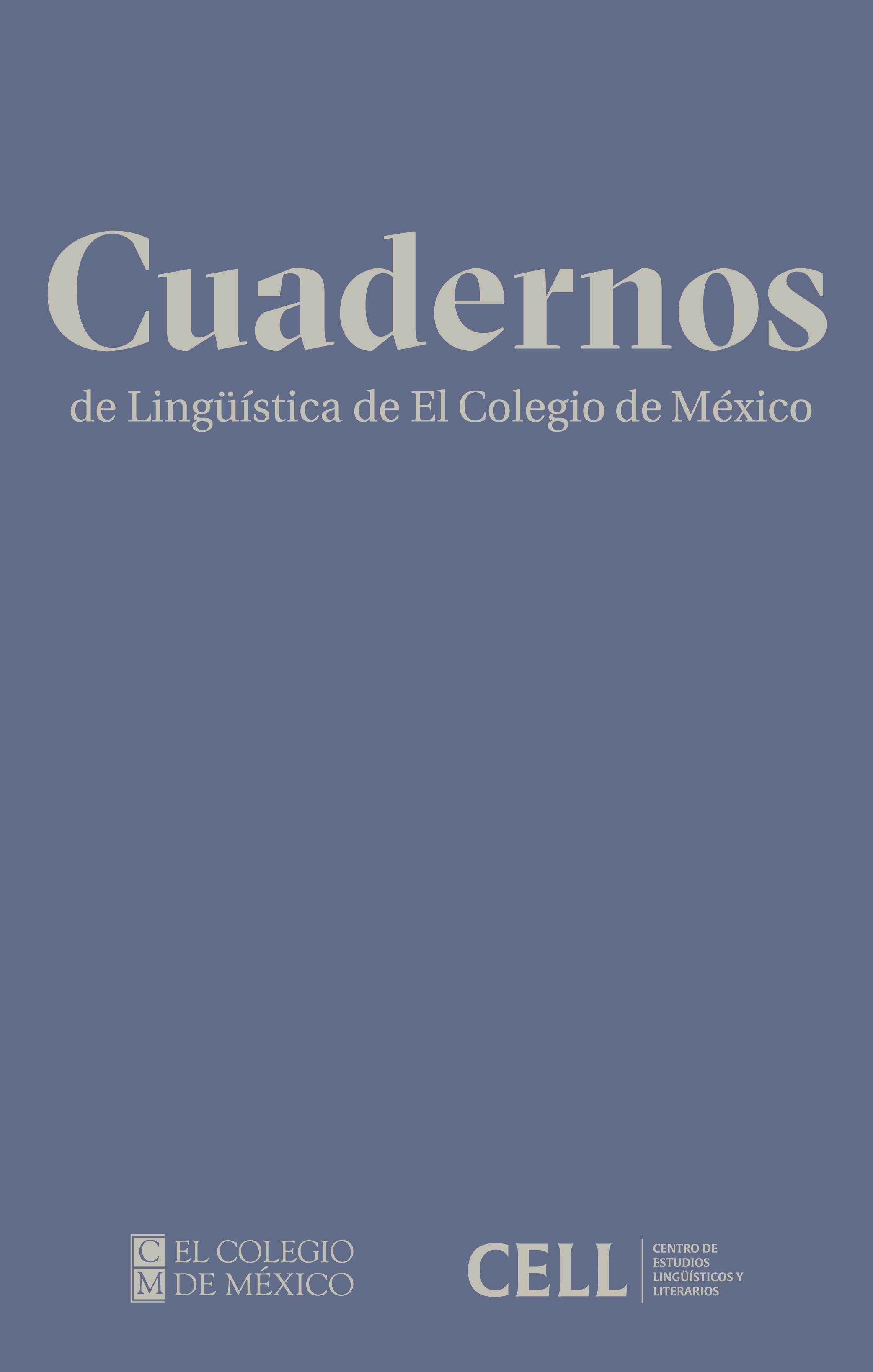A phonological sketch of the Santo Domingo de Morelos variety of Miahuatec Zapotec
DOI:
https://doi.org/10.24201/clecm.v11i00.311Keywords:
Otomanguean languages, tonal languages, phonology of underrepresented languages, phonation typesAbstract
The phonology of the Santo Domingo de Morelos Miahuatec exhibits the typical features of Southern Zapotec languages: (1) it is a tonal language with two-level tones (high, low), and two contour tones (falling, rising), (2) it has non-modal phonation (laryngealization) (3) it shows an iambic (light-heavy) stress pattern, and (4) the fortis-lenis distinction covers both the segmental phonology and the moraic structure. Miahuatec Zapotec also displays some innovative features: (1) the constricted glottis feature is linked on the sec- ond mora of stressed syllables, (2) the fortis-lenis contrast is present only on non-sonorant consonants, (3) there are four contrastive tones and a surface extra high tone in the clitic group, (4) it exhibits a rare pattern of consonant clusters based on the fortis-lenis contrast, and (5) the acoustic correlates of stress are the duration of the rhyme instead of vowel duration or intensity, as has been proposed for other Zapotec languages.
Downloads
References
Antonio, Pafnuncio. 2015. La fonología y morfología del zapoteco de San Pedro Mixtepec. Centro de Investigaciones y Estudios Superiores en Antropología Social. (PhD thesis.)
Arellanes, Francisco. 2021. Contraste fortis-lenis en zapoteco: aspectos sincrónicos y diacrónicos, in Arellanes, Francisco & Guerrero, Lilián (eds.), Estudios lingüísticos y filológicos en lenguas indígenas mexica nas. Celebración de los 30 años del Seminario de Lenguas Indígenas, 395 450. Mexico: Universidad Nacional Autónoma de México.
Arellanes, Francisco. 2009. El sistema fonológico y las propiedades fonéticas del zapoteco de San Pablo Güilá: descripción y análisis formal. Mexico: El Colegio de México. (PhD thesis.)
Beam de Azcona, Rosemary. 2015. Valency-changing devices in two Southern Zapotec languages, in Operstein, Natalie & Huey Sonnenschein, Aaron (eds.), Valence changes in Zapotec: synchrony, diachrony, typology. Los Angeles: John Benjamins. https://doi.org/10.1075/tsl.110.08bea DOI: https://doi.org/10.1075/tsl.110.08bea
Beam de Azcona, Rosemary. 2013. El hombre que conoció a Cosijo. Tlalocan 19. 93-223. https://doi.org/10.19130/iifl.tlalocan.2013.228 DOI: https://doi.org/10.19130/iifl.tlalocan.2013.228
Beam de Azcona, Rosemary. 2009. Clasificación de verbos en el zapoteco miahuateco de San Bartolomé Loxicha. Cuadernos del Sur 14.
Beam de Azcona, Rosemary. 2008. Un estudio comparativo de los tonos del zapoteco sureño, in López Cruz, Ausencia & Swanton, Michael, (eds.). Memorias del coloquio Francisco Belmar: las lenguas otomangues y oaxaqueñas ante el siglo XXI, 161-185. Oaxaca: Fondo Editorial IEEPO / INALI / Universidad Autónoma Benito Juárez de Oaxaca / Fundación Alfredo Harp Helú.
Beam de Azcona, Rosemary. 2004. A Coatlan-Loxicha grammar. University of California, Berkeley. (PhD thesis.)
Birtles, Daniel & Black, Cherly. 2009. The negation system of Loxicha Zapotec. Mexico: Summer Institute of Linguistics.
Blankenship, Barbara. 2002. The timing of no modal phonation in vowels. Journal of Phonetics 30.163-191. https://doi.org/10.1006/jpho.2001.0155 DOI: https://doi.org/10.1006/jpho.2001.0155
Chávez-Peón, Mario. 2012. The interaction of metrical structure, tone and phonation types in Quiaviní Zapotec. University of British Columbia. (PhD thesis.)
Clements, George. 1990. The role of the sonority cycle in core syllabification, in Kingston, John & Beckman, Mary E. (eds.), Papers in laboratory phonology I: between the grammar and physics of speech, 283-333. Cambridge. DOI: https://doi.org/10.1017/CBO9780511627736.017
Covarrubias, Adela. 2020. Fonología del Dizdea: zapoteco de San Bartolo Yautepec. Mexico: Escuela Nacional de Antropología e Historia. (Bachelor’s thesis.) DOI: https://doi.org/10.62190/amla.lmne.2021.3.1.5
Esposito, Cristina. 2004. Santa Ana del Valle Zapotec phonation. UCLA Working Papers in Phonetics 103. 71-105.
Esposito, Cristina & Khan, Sameer. 2020. The cross-linguistic patterns of phonation types. Language and Linguist Compass 14. 1-25. https://doi.org/10.1111/lnc3.12392 DOI: https://doi.org/10.1111/lnc3.12392
Gordon, Matthew. 2001. A typology of contour tone restrictions. Studies in language 25. 405-444. https://doi.org/10.1075/sl.25.3.03gor DOI: https://doi.org/10.1075/sl.25.3.03gor
Grønnum, Nina. 2014. Laryngealization or pitch accent - the case of Danish Stød. Proc. Speech Prosody 2014. 804-808. https://10.21437/Speech-Prosody.2014-150 DOI: https://doi.org/10.21437/SpeechProsody.2014-150
Hayes, Bruce. 1995. Metrical stress theory: principles and case studies. University of Chicago Press.
Hernández, Mario. 2020. Acento y legitimación del rasgo [glotis con- streñida] en miahuateco. Lingüística mexicana nueva época 3(1). 151- 171. DOI: https://doi.org/10.62190/amla.lmne.2021.3.1.6
Hernández, Mario. 2019. Fonología del miahuateco. Sincronía, diacronía y clasificación. Mexico: El Colegio de México. (PhD thesis.)
Hernández, Mario. 2016. Anclaje laríngeo en miahuateco. Talk at II Workshop on sound systems of Mexico and Central America. Universidad Nacional Autónoma de México.
Hernández, Mario. 2014. Desarrollo histórico y análisis sincrónico del sistema fonológico del zapoteco de Santo Domingo de Morelos. Escuela Nacional de Antropología. (Bachelor’s thesis.)
Herrera Zendejas, Esther. 2000. Amuzgo and Zapotec: two more cases of laryngeally complex languages. Anthropological Linguistics 42(4). 545-563.
Herrera Zendejas, Esther & Arellanes, Francisco 2008. La secuencia N+- fricativa y dos tipos de procesos reparadores: categorial y transicional, in Gutiérrez Bravo, Rodrigo & Herrera Zendejas, Esther (eds.), Teoría de la optimidad: estudios de sintaxis y fonología, 137-157. Mexico: El Colegio de Mexico. DOI: https://doi.org/10.2307/j.ctv6mtczh.9
Inkelas, Sharon. 1994. The consequences of optimization for under specification. Massachusetts: Graduate Linguistic Student Association / Dep. of Linguistics / University of Massachusetts.
Jaeger, Jeri. 1983. The fortis/lenis question: evidence from Zapotec and Jawoñ. Journal of Phonetics 11. 177-189. DOI: https://doi.org/10.1016/S0095-4470(19)30814-9
Jespersen, Otto. 1904. Lehrbuch der Phonetik. Leipzig/Berlin.
Kaufman, Terrence. 2016. Protosapotek(an) reconstructions. Available at: https://www.albany.edu/ims/pdlma/SapRec16%20for%20posting.Pdf
Maddieson, Ian & Ladefoged, Peter. 1990. Vowels of the world's languages. Journal of phonetics 18. 93-122. DOI: https://doi.org/10.1016/S0095-4470(19)30396-1
Michaud, Alexis. 2012. Monosyllabicization: patterns of evolution in Asian languages, in Stolz, Thomas; Nau, Nicole & Stroh, Cornelia (eds.), Monosyllables: from phonology to typology, 115-130. Berlin: Walter De Gruyter. DOI: https://doi.org/10.1524/9783050060354.115
Nellis, Donald & Hollenbach, Barbara. 1980. Fortis versus lenis in Cajonos Zapotec phonology. International Journal of American Linguistics 46. 92-105. DOI: https://doi.org/10.1086/465639
Pater, Joe. 2004. Austronesian Nasal substitution and other NC Effects, in McCarthy, John (ed.), Optimality theory in phonology: a reader, 271-289. New Jersey: Blackwell Publishing. https://doi.org/10.1002/9780470756171.ch14 DOI: https://doi.org/10.1002/9780470756171.ch14
Pater, Joe. 1996. *NC. North East Linguistics Society 26. DOI: https://doi.org/10.1515/iabi.1996.26.2.82
Prince, Alan & Smolensky, Paul. 2008. Optimality Theory: constraint interaction in generative grammar. New Jersey: John Wiley & Sons. https://doi.org/10.7282/T34M92MV
Ruegsegger, Manis & Ruegsegger, Jane. 1955. Vocabulario zapoteco del dialecto de Miahuatlán del estado de Oaxaca. Mexico: Summer Institute of Linguistics / Secretaría de Educación Pública.
Saussure, Ferdinand de. 1916. Cours de linguistique générale. Lausanne / Paris: Payot.
Selkirk, Elisabeth. 1984. Phonology and syntax: the relation between sound and structure. Cambridge, MA: The MIT Press.
Sicoli, Mark. 2007. Tono: a linguistic ethnography of tone and voice in a Zapotec region. University of Michigan. (PhD thesis.)
Silverman, Daniel. 1997a. Laryngeal complexity in Otomanguean languages. Phonology 14(2). 235-261 DOI: https://doi.org/10.1017/S0952675797003412
Silverman, Daniel. 1997b. Phasing and recoverability. New York: Garland.
Smith, Thomas. 2007. Algunas isoglosas zapotecas, in Buenrostro, Cristina; Herrera, Samuel; Lastra, Yolanda; Rendón, Juan; Schumann, Otto; Valiñas, Leopoldo & Vargas Monroy, María (eds.), Clasificación de las lenguas indígenas de México. Memorias del III Coloquio Internacional Mauricio Swadesh, 69-133. Mexico: UNAM / Instituto de Investigaciones Antropológicas / Instituto Nacional de lenguas Indígenas.
Smith, Thomas. 1982. Cédula para la elicitación preliminar de sintaxis y morfología. Manuscript.
Uchihara, Hiroto & Gutiérrez, Ambrocio. 2020. Open and closed mid-front vowels in Teotitlán del Valle Zapotec. Phonological Data & Analysis 2. 1-22. https://doi.org/10,3765/pda.v2art7.42 DOI: https://doi.org/10.3765/pda.v2art7.42
Published
How to Cite
-
Abstract428
-
PDF200
-
XML (Español)8
-
EPUB (Español)9
-
Kindle (Español)46
-
MP3 (Español)2
Issue
Section
License
Copyright (c) 2024 Mario Ulises Hernández Luna, Esther Herrera Zendejas

This work is licensed under a Creative Commons Attribution-NonCommercial 4.0 International License.
Authors retain copyright of their work and are free to disseminate it, make copies for any use, and/or deposit in any repository or archive of their choice, but they grant Cuadernos de Lingüística de El Colegio de México the right to publish the work for the first time. Authors agree to acknowledge Cuadernos de Lingüística de El Colegio de México as the site of original publication of their article / note / review through proper citation.
Articles appearing in Cuadernos de Lingüística de El Colegio de México are made available to readers under a Attribution-NonCommercial-NoDerivatives 4.0 International.









